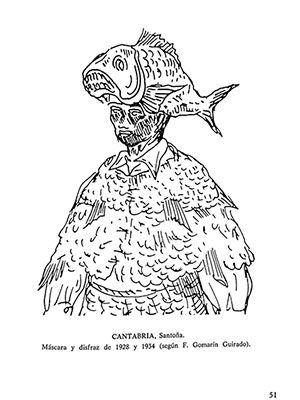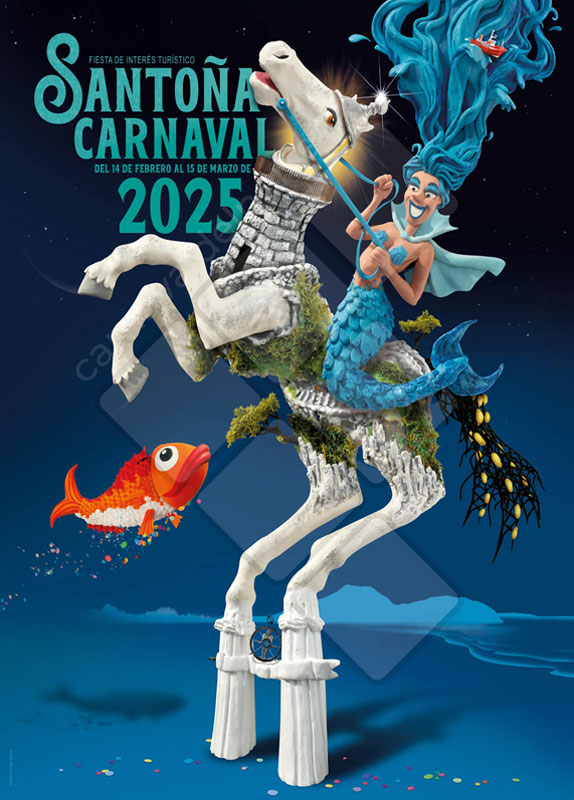All carnival songs receive the general name of murga, a term that also serves to designate the group that interprets it.
 The murga "Los Parrandistas" has gone down in the history of the carnival of Santoñés for having sung for the first time in 1934 the song "Judgment at the Bottom of the Sea", whose lyrics had been composed by Emilio González Revuelta "Litri", and the music by Vinatea, who was at the time the Director of the Municipal Band.
The murga "Los Parrandistas" has gone down in the history of the carnival of Santoñés for having sung for the first time in 1934 the song "Judgment at the Bottom of the Sea", whose lyrics had been composed by Emilio González Revuelta "Litri", and the music by Vinatea, who was at the time the Director of the Municipal Band.
"Los Parrandistas" were thirteen, plus three women aguinalderas, without disguise, who sold the songs not only in order to obtain money, but so that they were learned by the public when they heard them.
The instruments they used were made of cardboard, with a reed mouthpiece, the sound originated by vibrating a cigarette paper duly placed in a hole in the tube when it was propelled by the blow of the mouth. The bass drum consisted of a table of those used for herring.
When they acted they carried a broomstick to the end of which an inflated bladder was tied with which they beat the public, especially young ladies and kids.
In the couplet "Trial at the Bottom of the Sea" the abduction of a mermaid by a sea bream in love is recounted, and the trial to which he is subjected, serves as a pretext for the author to make a long and rich list of marine species common then in the Puerto Santoñés and today many of them practically disappeared. This is the lyrics of the old murga:
"....As announced by a radio
in the depths of the sea
, a zarabanda
has been set up that has given much to talk about.
Well, they say that if a bream
that is there an influential fish
of an innocent mermaid
has madly fallen in love.
And the sea bream in love
has bundled the luggage
and the mermaid has been kidnapped.
Neptune, god of the seas,
deeply upset
the matter has entrusted
a green man who is a lawyer.
And a thousand lawsuits he has won,
all in the salty sea.
To substantiate the lawsuit,
the lawyer has arranged to
open an information;
from the
tiniest fish to the most cunning muergo
give a statement.
The trial will take place
in the hollow of a rock
and adorned with marlotas,
sponges and seaweed.
Four divine sirens
will form the court
and one by one the fishes
before such severe judges
and at once they will parade.
Apparently an illustrious safeguard
who is thorny and literate
has been in charge of the defense of the inmate .
To act in the proceedings
and as a solicitor with
a very experienced fish
called the flying fish.
From the order of this place,
with extreme seriousness
, a huge swordfish will be commissioned very formally
.
Two thousand three hundred seabass
commanded by a luciato
armed with carbines will
form in that act.
And
the functions of janitor are entrusted
to two active soles
and an elegant pajel.
The porretanos and barbels
of the jury will act
and the defendant with their
acquittals will declare.
And in the room that will be
fixed from boat to boat,
suppose a cancaricote is
on duty.
And in strict order
from the dolphin to the slimy
statement they made:
toads, squids,
cuttlefish, trout,
palomenta, relaunches,
luciatos, cuttlefish and sulas,
groupers, turbot, julia,
red mullet, scorpionfish,
conger eel, whale, escachos,
hake, bocartes , sardines,
bonitos, taurons,
scrapie, sharks,
porretanos, chaparudos , hot dogs
, lampreys, weevils,
slimy brecas , tench,
pear-shaped fish and durdos.
They will also appear
to testify...."
Jose Luis Gutierrez Bicarregui














